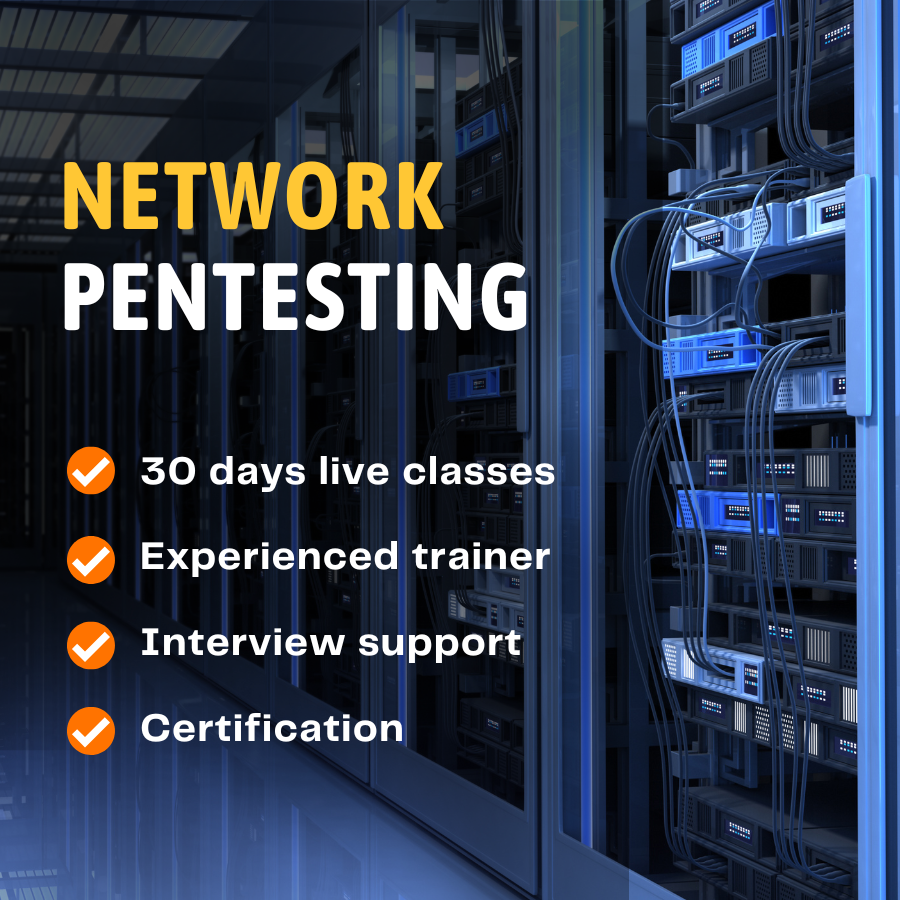Are you interested in taking your Network Pentesting skills to the next level? Do you want to learn the techniques for scanning, enumeration, exploitation, and post-exploitation in complex network environments? If so, this course is for you!
Who can Enroll the course:
- It is an open to anyone who is interested in learning about Network Pentesting and has a basic understanding of computer systems and networks. This course is specifically tailored for:
- Individuals who are new to the field of Network Pentesting and want to gain a foundational understanding of the tools, techniques, and methodologies used by Penetration Testers and Ethical Hackers
- Students and recent graduates who want to pursue a career in Cybersecurity or Network Penetration Testing
- IT professionals who want to expand their knowledge and skills in Network Security and Pentesting
No prior experience in Network Pentesting or Cybersecurity is required for this course. However, basic knowledge of computer systems and networks is recommended.
Skills you will learn after the course completion
- Conducting reconnaissance and information gathering activities to identify network assets and vulnerabilities
- Scanning and enumerating networks to identify open ports, services, and potential vulnerabilities
- Conducting vulnerability assessments and exploit development to identify and exploit vulnerabilities in network environments
- Conducting post-exploitation activities to maintain access and escalate privileges
- Understanding ethical and legal considerations of Network Pentesting, as well as best practices for conducting reporting and remediation activities
- Using various tools and technologies to conduct ethical hacking exercises on simulated network environments
- Developing a foundational understanding of computer networks and network security
Table of Content:
Module 0: Course Overview
- Overview of Network Pentesting and Ethical Hacking
- Explanation of tools and technologies used in the course
- Prerequisites for the course
- Recap of basic Network Pentesting concepts
Module 1: Basic Networking Concepts
- Introduction to basic networking concepts
- Understanding OSI and TCP/IP models
- Introduction to IP addressing and subnetting
- Overview of routing and switching
- Introduction to common networking protocols and their vulnerabilities
Module 2: Introduction to Network Security
- Understanding network security concepts and principles
- Types of network attacks
- Introduction to network vulnerabilities and threat modelling
- Overview of different network security solutions
Module 3: Network Scanning and Enumeration
- Introduction to network scanning and enumeration
- Explanation of tools such as Nmap, Nessus, etc.
- Understanding network topology discovery
- Enumeration techniques
Module 4: Network Scanning and Enumeration
- Introduction to scanning techniques and tools
- Understanding network topologies and protocols
- Enumeration techniques and tools for active and passive fingerprinting
- Vulnerability analysis and reporting
Module 5: Network Exploitation and Post-Exploitation
- Introduction to exploitation techniques and tools
- Exploit development and scripting
- Evading detection mechanisms such as IDS/IPS
- Techniques for maintaining access and privilege escalation
- Introduction to lateral movement and pivoting
Module 6: Web Application Penetration Testing
- Introduction to Web Application Penetration Testing
- Understanding OWASP Top 10 vulnerabilities and their exploitation
- Introduction to web application scanning and assessment tools
- Introduction to web application firewall (WAF) bypassing techniques
Module 7: Social Engineering and Physical Security
- Introduction to social engineering and physical security attacks
- Understanding different social engineering techniques
- Introduction to social engineering tools and frameworks
- Physical security assessment techniques
- Introduction to physical security exploitation techniques
Module 8: Reporting and Remediation
- Introduction to reporting and remediation
- Understanding different reporting formats and standards
- Introduction to remediation and mitigation techniques
- Discussing the importance of post-assessment activities such as debriefing and communication with stakeholders
Module 9: Conclusion
- Recap of the course content
- Discussion on the importance of advanced Network Pentesting
- Final thoughts and recommendations
- Future Scope and Path Discussion
- Jobs and Interview Discussions
Conclusion:
In conclusion, the “Network Pentesting” course is designed for beginners who are interested in learning the basics of Network Pentesting. This course provides a solid foundation in Network Pentesting concepts and methodologies, as well as hands-on experience using various tools and technologies to conduct ethical hacking exercises on simulated network environments.
By completing this course, you will have gained the necessary knowledge and skills to identify and exploit vulnerabilities in computer networks, and conduct post-exploitation activities. You will also learn about the ethical and legal considerations of Network Pentesting, as well as best practices for conducting effective reporting and remediation activities.
Whether you’re looking to pursue a career in Cybersecurity or Network Penetration Testing, or you simply want to secure your own network environment and learn the basics of ethical hacking, this course will provide you with the foundational knowledge and skills you need to get started.





Reviews
There are no reviews yet.